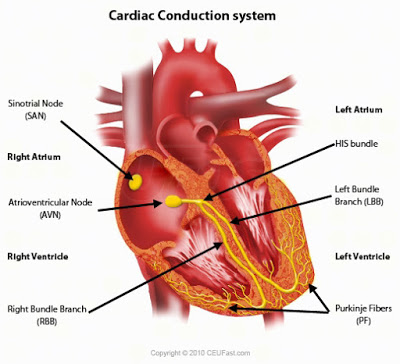In the previous article, we discussed Bioelectric potential, action and resting potential. In this article, we will talk about heart Cardiac Conduction System. A heart has its own electrical system that is responsible for the continuous generation and
A heart has its own electrical system that is responsible for the continuous generation and organised transmission of Electrical impulses in the heart. The heart contains a special cell that generates and transmits pulses from atria to ventricles.
Sinoatrial Node
It is also known as the natural pacemaker. A pacemaker is a group of specialized cells that spontaneously generate action potential at a regular rate. Sinoatrial node is present in the right atrium.
Heart beat is because of action potential generated by sinoatrial node. It transmits electrical impulses in the different direction along the surface of both atria.
These impulses reach atrioventricular node along the surface of both atria. The main function of the atrioventricular node is to provide proper timing between the action of atria and ventricle by delaying transmission of pulses.
After this, ventricles transmits an impulse to the interventricular septum called as Bundle of His. These fibres divide into left and right bundle branches, which transmits electrical impulses to the left and right ventricles respectively. The Cardiac Conduction System is shown in the figure below.
Properties of the Conduction System
The heart has some intrinsic properties i.e. excitability, conductivity, and automaticity. Let’s discuss one by one.
1. Excitability
It refers to the ability of a cell to respond to an electrical stimulus.
2. Conductivity
It refers to the ability of each cell of the conduction system to conduct individual electrical impulse from one cell to another cell.
3. Automaticity
It refers to an individual cell’s ability to Self-excite without any impulse from an outside source. Each component of the conductive system has its own intrinsic rate of self-excitation.
- Sinoatrial node has an intrinsic rate of 60 – 100 beats per minute.
- Atrioventricular node has an intrinsic rate of 40 – 60 beats per minute.
- Ventricular Conduction Tracts has an intrinsic rate of 15 – 40 beats per minute.
Note: The conductive tissue that has the fastest automaticity acts as the pacemaker of the heart. In a normal working heart, the sinoatrial node has he highest automaticity.
In case one pacemaker tissue fails to act, the conduction tissue with next highest intrinsic rate will gain control of the pacing function of the heart.

